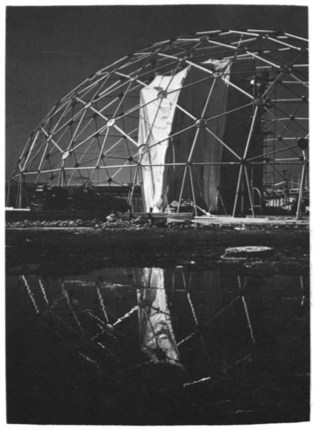
Maybe it’s because I was reading about Jean-Pierre Reynaud and Superstudio’s Quaderna furniture last night, but for the first time, I suddenly noticed the incredible, grid-like mesh gabion fortification and construction system that defines the forward operating bases in Afghanistan: HESCO.
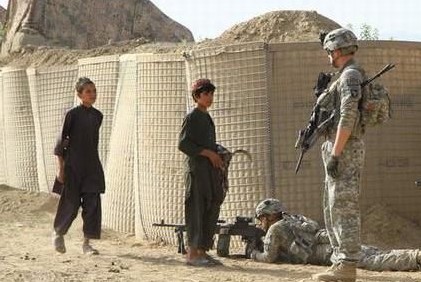
The HESCO Bastion Concertainer, obviously just called Hesco, is a galvanized steel mesh cage lined with non-woven polypropylene geotextile, which can be deployed with local fill ten time more quickly than sandbags, and with 90% less manpower.

It’s light enough to deploy by hand. It folds flat for easy transport. A shipping containerized system called RAID [Rapid In-Theatre Deployment] can be rolled out 1000 feet at a time from the back of a moving truck.
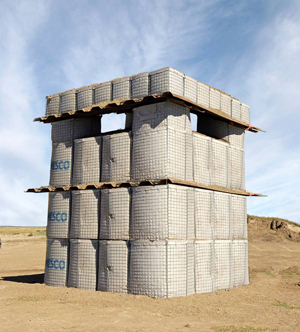
It protects against bullets, car bombs, and artillery fire, and it’s structural, so you can build with it. It’s water- and erosion-resistant, so you can do flood control with it. It’s ubiquitous in Afghanistan to the point of invisibility.
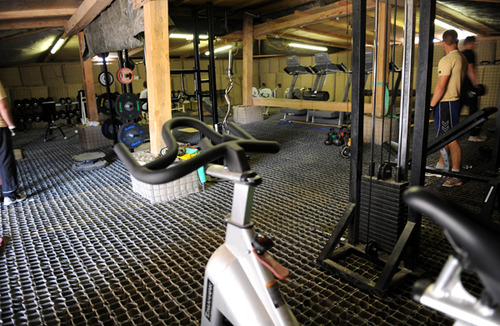
Which is where it starts getting really interesting. Here is a gym, constructed with Hesco pilings and a flattened out Hesco floor, built at a Hesco’d-out Australian forward gunnery base in Helmand last February.
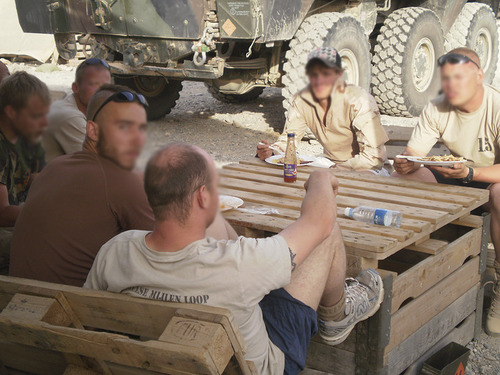
When Hesco meets the ingenuity that produces awesome, homebrewed field furniture knocked together from shipping pallets [above, below]
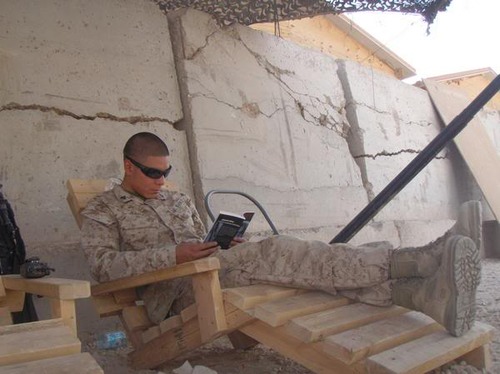
You end up with an entire Hesco living room set, including sofas, a TV stand and side table,
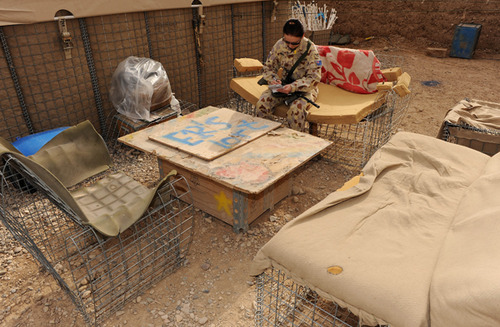
and club chairs and even a garbage can–all apparently noteworthy enough for a visiting commander to photograph and explain in 2010.

It’s like the Amerafghan love child of Staff Sergeant Frank Gehry. Admit it, wouldn’t you have paid more attention to the war if you’d known the troops were hacking such awesome design all this time? Please send more pics!
HESCO Bastions [hesco.com]
Field Furniture, from the Iraq & Afhanistan theaters [pallet images via militaryphotos.net]
12 February 2010 | Commander Joint Task Force visits Aussie gunners in Helmand Province Afghanistan [defence.gov.au]
Category: architecture
Jan Kaplicky Loved This Modular Construction System By, Uh,
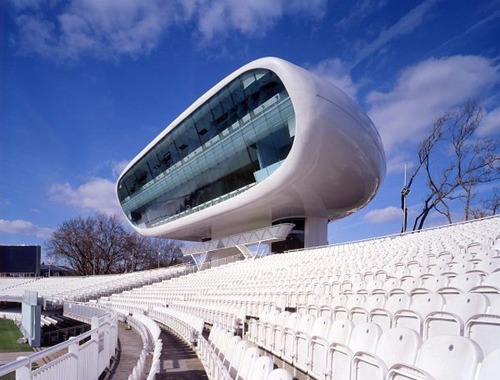
I just pulled out some Future Systems books last night, and I’d forgotten how hard I’d fallen for them. And though I knew they were The Future at the time, it’s still pretty awesome/eerie how much our 2006 ended up looking like their 1993. It seems like Jan Kaplicky and Amanda Levete’s tenacious, visionary modernist pursuits, their interest in prefab and industrial manufacturing in architecture and energy efficiency, became dominant themes, even as FS’s own practice split apart with the end of its principals’ relationship.
The other thing that seems prescient, for better or worse, is Kaplicky’s voracious image consumption. Those little source/idea books Future Systems put out, filled with hundreds of photos and drawings culled from the seductive, Western “image cascade” that washed over Kaplicky after he left Communist Czechoslovakia, feel exactly like the world’s favoritest tumblr.
[Of course, they also feel like a conditioned response to the multiscreen info overload of capitalist love the Eameses made for exhibition in Moscow in the Cold War, and Kaplicky’s own “vast collection” echos the 310,000+ piece image archive Ray Eames donated to the Library of Congress.]
But that’s the good part. Future Systems also anticipated the thing that most annoys the hell out of me about Tumblr and FFFound and the entire world now, the carefree casualness with credit and sourcing.
By that I obviously don’t mean I have hangups with attribution, or–double obviously–copyright infringement. [The title page of one catalogue has this refreshing disclaimer, “All reasonable efforts have been made to trace the copyright holders of the photographs. The Publishers and Future Systems apologise to anyone who has not been reached.”] It’s just that when I see an image that interests me, I want to know more. I want context. Origin. History. Tangents. I want to learn things that don’t necessarily only involve how something looks.
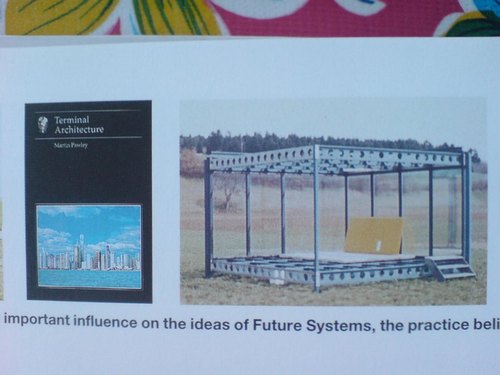
So anyway, does anyone recognize this kind of awesome prefab construction system Kaplicky included in his Influences: A Visual Essay [on the top of page 28 of Marcus Field’s 1999 Future Systems monograph, btw]? If I had to guess, I’d say it’s some random Prouvé follower, but that doesn’t narrow it down.
UPDATE And we have a winner, Doug from Materiality Office has identified Fritz Haller as the designer of this steel frame building system, probably from a house in Solothurn, Germany. Many thanks!
Alexander Girard Shelves? Alcoa Forecast Throwback
You know what I never got around to doing in 2010? Finishing the catalogue of all the designs created for the Alcoa Forecast ad campaign in the late 1950s.
That was the postwar, civilian/consumer-oriented, Glorious Aluminum Future PR campaign that gave birth to the Eames Solar Do-Nothing Toy. Which is by far its greatest claim to fame.
But still, there were other products, prototypes, designs, toys, sculptures, concepts. Like the ones I ran across in April 2010: Eliot Noyes’s design for a carport-like, aluminum & Perspex shelter; satelloon-esque, spherical prototypes for a portable oven by Greta Magnusson Grossman and the Music Sphere, a hi-fi by Lester Beall; and modular prismatic side tables by Isamu Noguchi. Then I found a couple of boring ones, and got distracted.
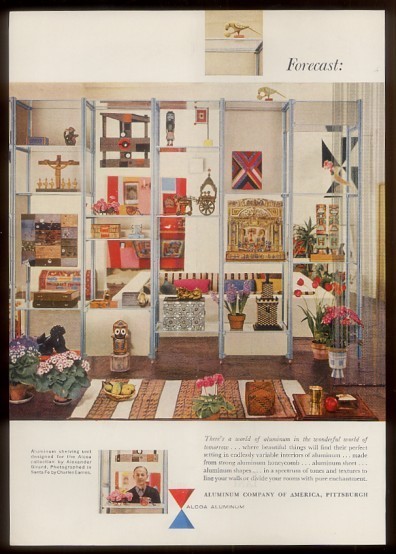
But I just stumbled across this tearsheet on eBay, which is probably from the July 27, 1957 issue of the New Yorker, and which shows a shelving system Alexander Girard designed for the Alcoa Forecast campaign. The photo, shot in Santa Fe, at Girard’s house, was taken by Charles Eames. Which, according to the timeline of John Neuhart, the Eames employee who actually created it, is about when the Solar Do-Nothing Machine was realized.
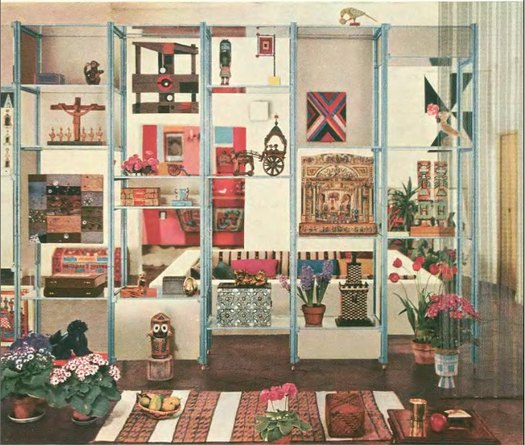
So Girard. Hmm. Overall, of course, awesome. But the shelves themselves? I gotta say, I’m not feeling it. The various panels in milk or smoked glass are fine, but the tubular metal seems off, and the feet are a mess.
The image itself seems to be more successful, or interesting, the way it collapses background and foreground into the shelves, which is funny, since they’re ostensibly meant to divide the space they inhabit, not flatten it. That Four Seasons-looking chain curtain thing on the right is especially odd/cool. And that Mary Heilmann painting top-center is freaking awesome.
WWPD?
Yes, I know I should be praising Norman Foster for his Dymaxion Car, which, of course.
But instead, I will be grateful for the deftness of Lord Foster’s humblebraggadocio in the essay he wrote for his wife’s show/book in Madrid on Jean Prouvé.
[Best line hands down: “He reviewed the drawings in silence. then said, simply: ‘You don’t need me – it’s perfect as it is.'”]
In discussing his firm’s work at the Free University of Berlin, which included the extensive renovation of the Rostlaube, or “Rustbucket,” the affectionate name given to Prouvé’s innovative-but-decaying CorTen-clad library:
Our approach from the start was not to ask ‘How can we match what Prouvé did?’, but to try to imagine how he would have responded, given the same challenge. So instead we asked: ‘How can we do what Prouvé would do now?’
We could have used Corten steel in much thicker sections, which technically would have been correct. But if Prouvé had known that the material needed to be sized differently, and that was his starting point, then the result would have been very different too. Most likely he would have looked at the alternatives and chosen a material that could be detailed finely and would stand the test of time; and so that’s what we did. We replaced the corroded panels and framing with new elements made from bronze, which as it weathers and acquires a patina is gradually taking on the colour tones of the original.
Which is what happened, eventually, I’m sure. But when it was done, the library looked as awesomely, hilariously shiny as a new Pfennig.

Do they still have Pfennig? I guess they will soon enough.
Foster on Prouvé [blueprintmagazine.co.uk, image via busse]
Unrelated, unmentioned, and most probably not WPWD: Foster & Partners’ cuh-razy Library of Philology at Free University Berlin [fosterandpartners]
Carlo Mollino, Becky Beasley, ‘The Outside’
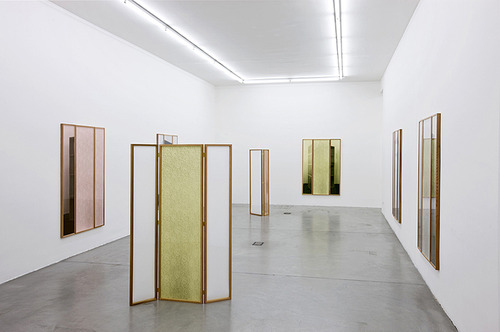
Let me tell you, spare, door-sized black & white prints in screen-like triptychs are not what I think of when I hear “Carlo Mollino” and “photography.” [Google search possibly nsfw]
But Becky Beasley’s show “The Outside,” at Francesca Minini in Milan, is just that, an austere yet decorative-looking exploration of Mollino’s treatment of photography and public/private space. In a good, specific, abstract way, it looks positively Quaytman-esque.
Becky Beasley’s “The Outside” runs through Jan. 14, 2012 [art-agenda.com]
Bill Walton, In The Artist’s Studio

I’m really bummed to have missed The Gifting of Bill Walton’s Studio on December 4th, the extraordinary culmination of the ICA Philadelphia’s memorial recreation/exhibit of the late local master’s crowded workplace.
As ICA blogger/curator Rachel Pastan tells it, the event went of exactly as planned, with people trading memories and stories of Walton, and then choosing a memento from the studio–tools, brushes, scraps, materials, anything but finished sculptures–to take with them.
I guess it’s alright, because I’ve kind of been doing the same thing already, since 1996.
I found Bill Walton’s humble, powerful, minimalist, materialist sculptures when I was attending business school in Philadelphia. When Larry Becker Gallery had his second Walton show during my final semester, I splurged and bought a small piece–small even by Walton’s standards, though bigger than the gold or copper headless nail works he’d embed flush in the wall.
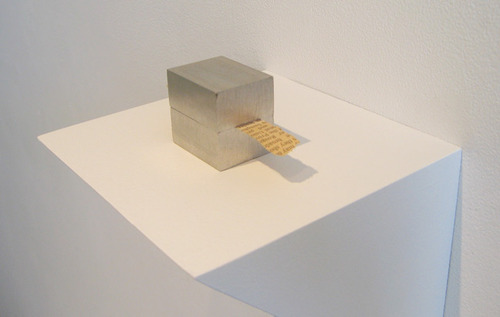
It’s a strip of lead an inch or so wide, carefully folded back and forth on itself into a little stack, almost like a cube. Pinched between one of the folds is a single 10″-inch blade of dried grass. In concept, it’s similar to the aluminum block & newspaper work Walton showed at Patricia Sweetow Gallery in 2005 [above]. [BTW, I love that he didn’t date his works. They exist among themselves, not in a timeline or progression.]
Becker explained that it was common to the streets of Philadelphia, and should I ever need to replace the grass, I could go out and find it. The species of grass is included on the label on the little custom-built archival cardboard case–it’s put away right now, so I can’t look it up–and Walton helpfully included a couple of spares behind a taped sheet of glassine.
Becker had shown the little sculpture on a small, white wall bracket about the size of a CD-case. For a while, I alarmed Becker by telling him how I had placed the sculpture on a cinnabar lacquered netsuke stand I’d found in the basement of my globetrotting landlady’s townhouse.
I was very interested at the time in the way Western modernism and minimalism resonated with Asian and Zen precursors–I was a groupie for John Cage’s Rolywholyover, which was at the Philadelphia Museum in 1995. And then later, when MoMA was choosing the architect for its expansion, I was translating criticism about Yoshio Taniguchi and his architect father Yoshiro Taniguchi, who had worked with Corbusier, designed the awesome mid-century modern Hotel Okura in Tokyo, and who founded Meiji-mura, an architecture preservation park which contains Frank Lloyd Wright’s Imperial Hotel.
But that’s several other stories. When my grass broke and my supply ran out, I began making a point to harvest a blade or two every time I went back to Philadelphia.
I kind of drifted away from a close following of Walton’s work after I left town, but Walton’s sculpture ends up occupying an outsize mental space for me, and it continues to link me to the city where Walton made it–and where I found it during my 2-year sojourn.
The transfiguration of Bill Walton’s studio [icaphila.org]
Gettysburg And The Disney/Ken Burns Effect
The new issue of Public Art Dialogue is out–as you know, right?–and it includes an article by Drake University art historian Maura Lyons that looks at how Disney, photography, and Ken Burns altered the Gettysburg National Military Park.
In the 1990s, the National Parks Service decided to reconfigure Gettysburg toward a “historically authentic” representation of the landscape as it appeared during the pivotal three-day battle in 1863, emphasizing the sites of action. After visiting the battlefield last year, I wrote [and wrote] about the problematic inconsistencies and selectivity of the strategy, which seemed to me like a retrofitted justification for an anti-modernist campaign to remove Richard Neutra’s Cyclorama building. Which it may still be, but not only that.
The NPS, Lyons argues, was trying to shore up the memorial’s relevance–and revenue–by responding to other presentations of Civil War history:
The landscape historian Brian Black has argued that the new direction for preservation at Gettysburg was partially motivated by the fact that, during the 1990s, the Walt Disney Company was planning to develop a historically themed park named Disney’s America in northern Virginia…NPS identified Disney as a possible economic threat an moved to solidify Gettysburg’s historical landscape as an authentic and authoritative one. In these efforts they could take advantage of a feature that Disney did not possess: the national park’s location on a notable battlefield.
Part of what helped kill Disney’s America, of course, was its proximity to another major Civil War site, the Memorial in Manassas to the Battles of Bull Run.

Alexander Gardner, The home of a Rebel Sharpshooter, Gettysburg 1863
As for photography, Lyons cites Gettysburg Then & Now, William Frassanito’s decades-long research project to identify and reshoot the sites of vintage, battle-era photographs. And a study by Jim Weeks, who found that
the desires of visitors, who want to see visions of the battlefield familiar to them from historical photographs, particularly from their deployment in Ken Burns’ documentary series The Civil War…helped prompt the restorations of the last 20 years… Weeks observes that “While in earlier phases Gettysburg controlled its image, by the latest phase images controlled Gettysburg.”
Lyons, Maura, “Memorialization and Marginalization: Vernacular Sites and the American Civil War,” PAD Journal, vol. 1, no. 2, pp163-191 [tandfonline.com]
Previously: Some pointers, or what to do with Neutra’s Gettysburg Cyclorama Center?
Considering The Eameses As Artists
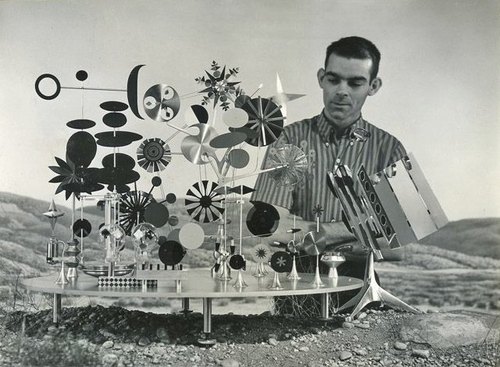
A few months ago, I was asked to write something about Ray and Charles Eames by the folks at Humanities Magazine, published by the National Endowment for the Humanities.
The NEH had provided some funding to Jason Cohn and Bill Jersey’s documentary, Charles & Ray Eames: The Architect and the Painter, so a straight-up review wouldn’t really work. But I was encouraged by the documentary’s title, and its exploration of Ray’s role in the duo’s collaborative process, and so I decided to float the idea that there’s a lot to learn by considering the Eameses as artists:
Throughout their own careers, whether making architecture, furniture, toys, annual reports, or films, the Eameses presented themselves as designers. And despite their forays into education, computing, and international diplomacy, that’s how they are typically seen. But calling the Eameses designers while trying to account for their polymathic legacy can be problematic, particularly if we’re picturing the designer as a lone, heroic genius: Charles Eames as the Howard Roark of American consumer capitalism. It invites many esoteric and academic questions about process, context, gender, and collaboration, which are interesting but hard to resolve. When considered from an artistic perspective, however, many of these complications evaporate. Accepting Ray and Charles Eames as artists and their studio work as art gets us away from the arbitrage over who did what and how. Plus, it enriches and deepens the contemporary understanding of their role in the culture of their time.
That’s John Neuhart up there, by the way; he built the Eameses’ greatest object besides their house, and one of the greatest unsung, unrecognized artworks of the modernist era, the Solar Do-Nothing Machine.
Modern Love, Humanities Magazine, Nov/Dec. 2011 [neh.gov]
The New Aesthetic On Stage
Here’s video of James Bridle giving a live, keynote speech version of his awesome tumblr, The New Aesthetic, at a web conference in Australia. Lots of good stuff, though not much that will be new to TNA followers.
There are a few greg.org favorites in there, too, including lots of camo, Dutch Google camo, Blurmany, that crazy Google Books book, Google Google Google camo camo camo.
Waving At Machines, at Web Directions South, Sydney AU [booktwo.org]
Everything And The Kitchen Sink
We took the family to Hillwood over the holidays. It’s Marjorie Merriweather Post’s house-turned-house museum, and it’s kind of bizarre, frankly. Not seriously wack, but just a low-grade oddness which, who knows, maybe the passage of time and the accretion of history will help mitigate, and 50 years from now, it’ll be Washington’s Frick Museum. But it’s not yet.
Hillwood is a sprawling memorial to the oft-married heiress/socialite’s extravagant but ultimately middlebrow taste. The house is kind of big, but mostly grand, similar in scale and layout to the White House, but in Georgian/James River revival style, built in the 1920s. The storm doors on the terrace entrances look like the ones on every postwar red brick grandma house in Washington. The gardens are sprawling, but conventional.
Post’s collections are a docent’s paradise: tons of factoids to be shared about piles of French furniture, Sevres porcelain, Russian baubles and czarist portraits. And antique miniature furniture. None of it was as interesting as the positively massive cut crystal pendants hanging from every sconce and chandelier; seriously, grapefruit- or palm-sized or bigger, almost every one.
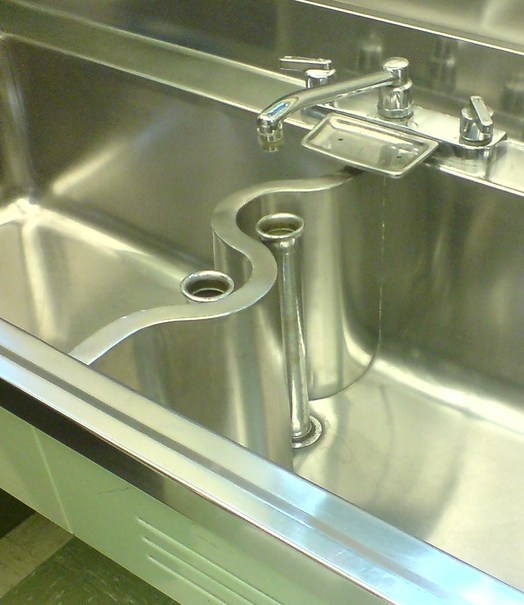
And so my favorite room ends up being the kitchen, which is fantastic. It’s huge and vintage and all stainless steel, acres of Lustertone countertop, with a couple of sections of Formica and marble. It’s a rare testament to the blind folly of our renovation-mad real estate culture. Keep your vintage kitchens, people, are you crazy?? [That pink tile and rococo gold-plated fixture master bathroom, OTOH, yow. A cautionary tale.]
Anyway, point is, this awesome double sink thing here in the butler’s pantry? What is going on with this? I think it’s stamped Geneva on the front edge. It is spectacular. Made my day.
Kim Schoenstadt At–Whoa, UMOCA
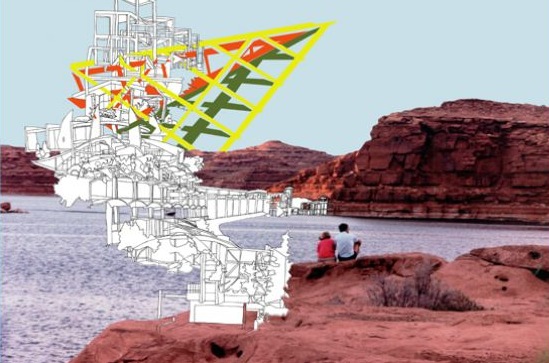
A little while ago, I got an email from LA-based artist Kim Schoenstadt, asking if it was alright to reference some photos I took a few years ago of unusually awesome modernist houses in Salt Lake City. She planned to incorporate drawings based on parts of the photos into a larger landscape/installation at her Doctorow Prize exhibition at the Salt Lake Art Center.
Obviously, yeah, fire it up, I said.
And then just now, I popped on over to the SLAC website to see how it all turned out, and it looks great. There’s a participatory drawing/paint-by-numbers/vinyl sticker reveal component of the show I’m not quite grasping, but it should make sense when we see it in person in a couple of weeks.
Meanwhile, holy smokes, the Art Center announced today that it has changed its name to the Utah Museum of Contemporary Art. Which is a thing I can barely imagine exists, but there it is. And to think it was once called the Art Barn. Mazeltovs all around out there.
Utah MOCA Doctorow Prize – Inaugural Exhibition, Kim Schoenstadt [utahmoca.org, which domain name was registered in Aug 2010, so maybe I’m just the last to know]
Kim Schoenstadt [kimschoenstadt.com]
Where Is Enzo Mari’s ‘Where Is The Craftsman?’
In what is probably the most ideologically analytical essay ever written about paperweights, curator Barbara Casavecchia notes that many of the 60 paperweights she selected from Enzo Mari’s collection “are the product of a manual labor–serving as fragmented evidence of the persistence of non-alienating forms of work, specifically within the craftsman-like dimension inherent to production that Mari has investigated for years.”
One incarnation of Mari’s investigation was an exhibition and discussion forum he organized in 1981 titled, “Dov’e l’artigiano”/”Where is the crafstman”. It was presented first at Fortezza da Basso in Florence, and then at the Triennale in Milan. There was a catalogue published–which I can’t find anywhere–and at least one review–which I can only find a few quotes from, but otherwise, the Italians have not yet processed or digitized their contemporary design history yet.
In his latest book, Venticinque modi per piantare un chiodo/25 ways to drive a nail, Mari says the objective was to “illustrate the unresolved ambiguity of the relationship between industrial design and ‘handmade.'”
Excerpts from an Ottagono review of “Dov’e l’artigiano” place the show and Mari’s critical view of the alienating labor conditions of mass production at the center of the debate over Italian design, culture, business, even a national identity of sorts. On the one hand, some Italian producers, still modernizing, hid the fact that their consumer products were partially made by hand because they “did not want to lose the noble title” of industrial design. And others hid the fact that they’d begun using industrial manufacturing processes because they didn’t want “to lose the prestigious title of an object ‘made by hand.'”
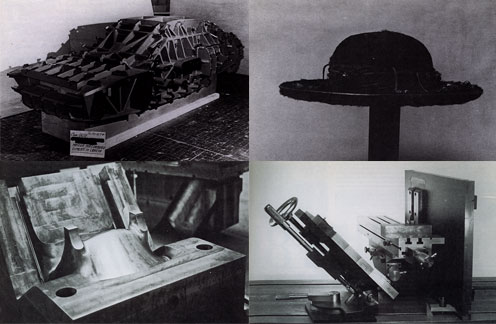
As he had done in 1973 with his autoprogettazione plans, exhibition, and product line, Mari eschewed theoretical arguments in favor of a “didactic exhibition” of objects and the close analysis of their creation. For the show he uncovered hundreds of examples of artisanal and craftsman-like processes being used to make mass-produced industrial design. Here are the objects and categories I’ve been able to find so far:
- Industrial prototypes and models made by craftsmen, such as hand-formed auto body parts by Italdesign’s Giorgetto Giugiaro and Aldo Mantovani for Alfa Romeo [top left, I think]
- Scale models and testing prototypes of turbines.
- A hand-made mold for high-quality plastic chairs [bottom left].
- The schematic drawing for an integrated circuit, which apparently took over 1800 man-hours to create. [I believe it]
- “Technological masterpieces” such as US nuclear submarines, one-off industrial objects.
- An 18th-century-style table with legs “built in series with industrial machinery, but finished with a stroke of the chisel to make it ‘unique.'”
- A Borsalino custom-made for the Pope [top right].
- A machine-like sculpture by Mari collaborator Paolo Gallerani [bottom right].
Oh yeah, and the whole show took place inside a geodesic dome.
I’ll add more objects and pictures if/as I find them. It’s hard to process a 30-year-old exhibit you’ve only just found out about. But it makes me think of things like, well, obviously, pen plotters and that insane William Shatner integrated circuit drawing movie. And NASA workers using giant clothespins to glue the mylar strips toghether for Project Echo satelloons. And Richard Serra sculptures made in defunct shipyards and Richard Prince car hoods. And hand-embroidered Gap kids’ dresses that turn out to have been made by children in India. And etsy and custom Nikes and pre-stressed jeans. And Ikea furniture that offloads all the non-alienating labor processes onto the customer.
Which is all by way of saying I have no grand theories on the current state of the relationship between craft and industrial production; but I think they’ve turned out to be not quite as incompatible as they seemed in 1981.
LINKS/RELATED
This all started with the catalogue essay for Enzo Mari: Sixty Paperweights, An Intellectual Work, which just closed in Berlin. [kaleidoscope-press.com, tanyaleighton.com]
Maddamura’s discovery of the Ottagono review is one of the few online sources of info on the “Dove’e l’Artigiano” show [image, too: maddamura.eu]
Mari’s new book, 25 Ways to Drive A Nail, is not available in English yet. [google books tho]
‘You Are Good Dome Builders.’
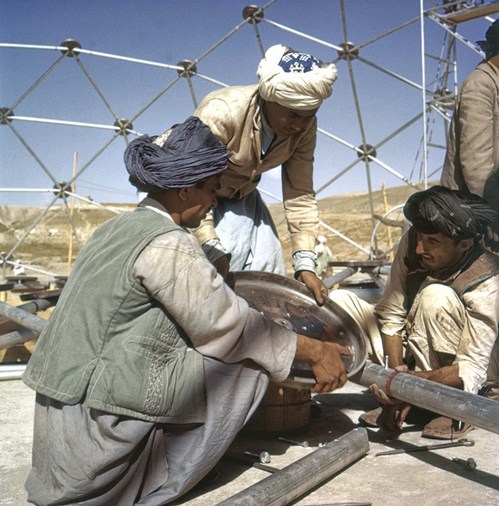
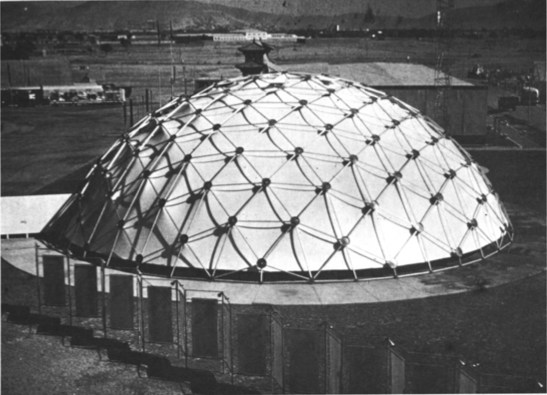
(K-2-28) This is the first of our United States, Department of Commerce, Trade Fair domes. It was erected in Kabul, Afghanistan in 1957. The U.S. Department of Commerce came to me in an emergency and with a very small budget. We were given thirty days to design and produce this structure, which we succeeded in doing. It had to be so designed that it could be folded up and put into one DC-4, which was all that was available for that task. It had to be flown across the ocean to Afghanistan, accompanied by only one of my engineers. All its parts were color coded so that the Afghan people were able to erect it by putting the red end to the red hold on the hub and the blue to the blue, etc. The Afghans didn’t know what they were building at all. They thought it was meant to be a conventional rectilinear structure, but suddenly found they had produced a hemispherical structure. They were bogle [sic] eyed and excited. The workers began to shoot-the-shoots [sic] down the taut nylon-geon-skin of the dome. The king of Afghanistan acclaimed the dome.
World society is accustomed to the concept of an architectural design which is erected by skilled craftsmen who’s [sic] skill, a priori, permitted the architect to design the kind of building which the craftsmen build. It was up to the architect to keep in mind that which the craftsmen could build.
In the case of our Afghan dome, when the Afghan people saw that the Afghan workmen had put up a new dome structure they attributed its spherical success to the Afghans’ craft skill. They said to the Afghan workmen shooting the shoots down the dome, “You are good dome builders.” The workmen replied, “Yes we are” and the Afghans applauded. So they said it was obviously Afghan architecture–a modern plastic and aluminum super-yurt. This made our dome the hit of the Kabul 1957 Trade Fair and the U.S.A. Departmetn of Commerce who had originally taken on the dome only as a last minute emergency device to stay within budget yet meet a challenge decided to see if this unexpected geodesic virtue, of popular appeal, would meet with equal favor elsewhere. It did time and time again.
This is a picture of the same Afghan dome which being 100% demountable, without parts loss or deterioration, went on economically in disassembled condition successively by air to New Delhi, Bangkok, Burma, Tokyo, the Philippines, and then down to Lima, Peru, on the west coast of South America and is now back in Africa again. This geodesic dome is now on its second local-stop trip around the world by air. It now has many counterparts doing the same.
Buckminster Fuller, from World Design Science Decade 1965-1975, Document 2: Inventory of World Resources, Human Trends And Needs, 1963, pp. 78-9. [All WDSD documents are available for download at the Buckminster Fuller Institute.]
Previously: Welcome to the Kabul Dome
In Afghanistan Did Buckminster Fuller A Statecrafty Geodesic Dome Erect
Let’s See You Try To Pepper Spray Them NOW, Hmm?
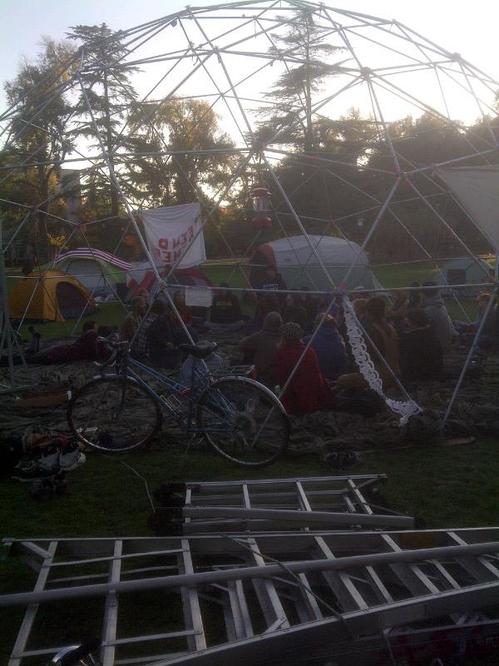
Wait, the UC Davis Occupy protestors built a 30-foot geodesic dome for their general assembly? Of course they did.
This is not a drill, people. Welcome to the Pepper Dome.
[image via @amychamp]
Previously: jackboot, Bean Boot
Chinese Google Earth Art Project
I confess, I haven’t checked out Utah’s Dugway Proving Grounds since the Terraserver era. But I just checked them out again
This crazy, Toyo Ito-ish tangle of 20m-wide white lines in the desert of Gangsu province have been stumping folks on Googlesightseeing for 2+ years. [Scrolling down, they found Google Earth images of the feature under construction in the spring of 2005.]
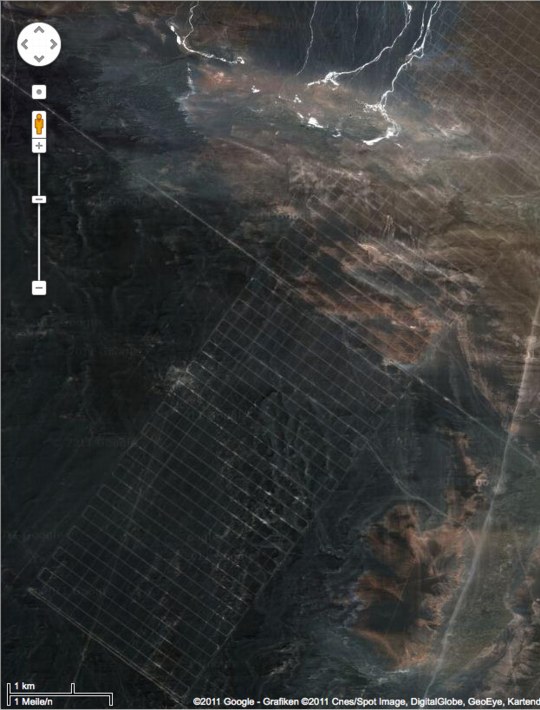
This is my favorite, though, an 18-mile-long grid [!] in Xinjiang. The speculation is that it’s a calibration grid for Chinese spy satellites. I like to think of it as the world’s biggest Agnes Martin painting.
Gizmodo’s been adding more Chinese Google Earth oddities to their original post. I’d still put Dugway into the top 3, or at least the top 5.
[thanks ryan, patrick, dt, and a couple of other people who also consider me their go-to guy for oddball Google earth art links.]

